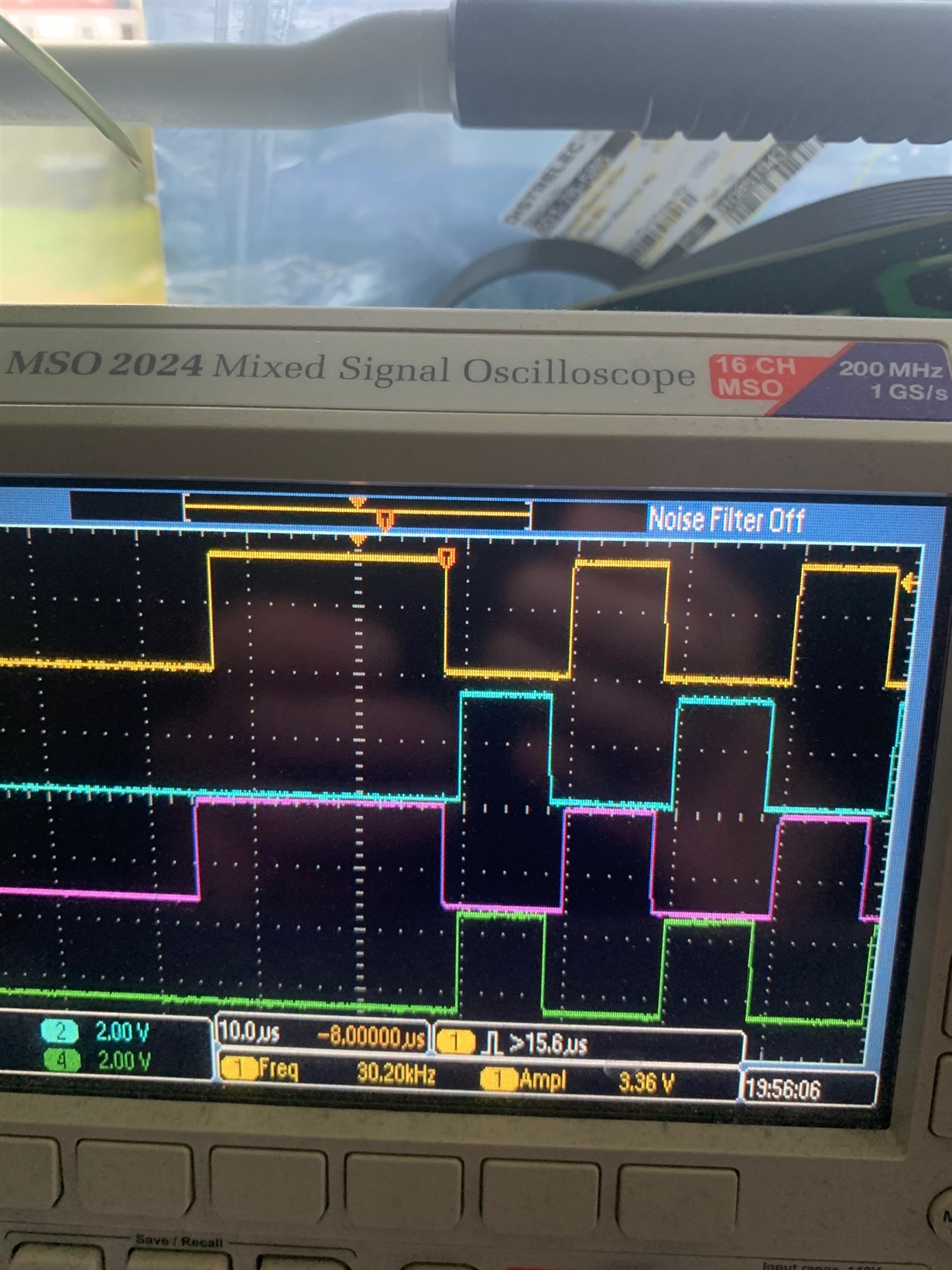Other Parts Discussed in Thread: UCD3138
Tool/software: Code Composer Studio
Hi,
We have included TMS320F28033PAG in our design to control an H bridge (four IGBT:s)
This is a frequency controlled LLC bridge
This is done by using two main output PWMs with one shadow PWM each that runs 180 degrees phase shifted with dead time.
However, we see problem with one of the PWMs (main and shadow) when phase shifting it compared to the other main PWM
Of we have zero on phase shifting at start (TBPHS=0) we see a missing pulse when starting to increase the phase shift to a very small value, see picture below
If we start the pwm set with a very small phase shift (TBPHS = 0.001) at initialization we see the missing pulse directly when the microcontroller starts to generate pulses at the PWMs, see picture below
We do not want to see any missing pulses.
Is this possible to perform?
See the init setup of the PWMs below
Are we using this in a incorrect way?
Thank you
Best regards
John
EPwm1Regs.TBCTL.bit.PRDLD = TB_IMMEDIATE; //TB_SHADOW;
EPwm1Regs.TBPRD = (MD_DRIVER_PERIOD_CYCLES - 1);
EPwm1Regs.CMPA.half.CMPA = (MD_DRIVER_PERIOD_CYCLES / 2); // 0;
//EPwm1Regs.CMPA.half.CMPA = 0; // No pulses
EPwm1Regs.TBPHS.half.TBPHS = ZERO_PHASE_SHIFT;//0; // Set phase register to 0
EPwm1Regs.TBCTL.bit.CTRMODE = TB_COUNT_UP; // Count up
EPwm1Regs.TBCTL.bit.PHSEN = TB_DISABLE; // Master module
EPwm1Regs.TBCTL.bit.SYNCOSEL = TB_CTR_ZERO;
EPwm1Regs.TBCTL.bit.CLKDIV = TB_DIV1; // No prescaler
EPwm1Regs.TBCTL.bit.HSPCLKDIV = TB_DIV1;
EPwm1Regs.CMPCTL.bit.SHDWAMODE = CC_SHADOW;
EPwm1Regs.CMPCTL.bit.SHDWBMODE = CC_SHADOW;
EPwm1Regs.CMPCTL.bit.LOADAMODE = CC_CTR_PRD; //CC_CTR_ZERO;
EPwm1Regs.CMPCTL.bit.LOADBMODE = CC_CTR_PRD; //CC_CTR_ZERO;
EPwm1Regs.AQCTLA.bit.ZRO = AQ_SET;
EPwm1Regs.AQCTLA.bit.CAU = AQ_CLEAR;
EPwm1Regs.DBCTL.bit.OUT_MODE = DB_FULL_ENABLE; // Deadband enabled
EPwm1Regs.DBCTL.bit.POLSEL = DB_ACTV_HIC; // Activate complementary B-channel
EPwm1Regs.DBCTL.bit.IN_MODE = DBA_ALL; // EPWMxA is the source for both falling- and rising-edge delays
EPwm1Regs.DBRED = DRIVER_RISING_EDGE_DELAY_CYCLES; //counter clocked by system clock 60MHz
EPwm1Regs.DBFED = DRIVER_FALLING_EDGE_DELAY_CYCLES;
//////////////////////////
// PWM 2
EPwm2Regs.TBCTL.bit.PRDLD = TB_IMMEDIATE; //TB_SHADOW;
EPwm2Regs.TBPRD = (MD_DRIVER_PERIOD_CYCLES - 1);
EPwm2Regs.CMPA.half.CMPA = (MD_DRIVER_PERIOD_CYCLES / 2); // 0;
//EPwm2Regs.CMPA.half.CMPA = 0;
EPwm2Regs.TBPHS.half.TBPHS = ZERO_PHASE_SHIFT;//0; // Set phase register to 0 initially
EPwm2Regs.TBCTL.bit.CTRMODE = TB_COUNT_UP; // Count up
EPwm2Regs.TBCTL.bit.PHSEN = TB_ENABLE; // Slave module
EPwm2Regs.TBCTL.bit.SYNCOSEL = TB_SYNC_IN; // Sync
EPwm2Regs.TBCTL.bit.CLKDIV = TB_DIV1; // No prescaler
EPwm2Regs.TBCTL.bit.HSPCLKDIV = TB_DIV1;
EPwm2Regs.CMPCTL.bit.SHDWAMODE = CC_SHADOW;
EPwm2Regs.CMPCTL.bit.SHDWBMODE = CC_SHADOW;
EPwm2Regs.CMPCTL.bit.LOADAMODE = CC_CTR_PRD; //CC_CTR_ZERO;
EPwm2Regs.CMPCTL.bit.LOADBMODE = CC_CTR_PRD; //CC_CTR_ZERO;
EPwm2Regs.AQCTLA.bit.ZRO = AQ_SET;
EPwm2Regs.AQCTLA.bit.CAU = AQ_CLEAR;
EPwm2Regs.DBCTL.bit.OUT_MODE = DB_FULL_ENABLE; // Deadband enabled
EPwm2Regs.DBCTL.bit.POLSEL = DB_ACTV_HIC; // Activate complementary B-channel
EPwm2Regs.DBCTL.bit.IN_MODE = DBA_ALL; // EPWMxA is the source for both falling- and rising-edge delays
EPwm2Regs.DBRED = DRIVER_RISING_EDGE_DELAY_CYCLES;
EPwm2Regs.DBFED = DRIVER_FALLING_EDGE_DELAY_CYCLES;




